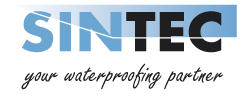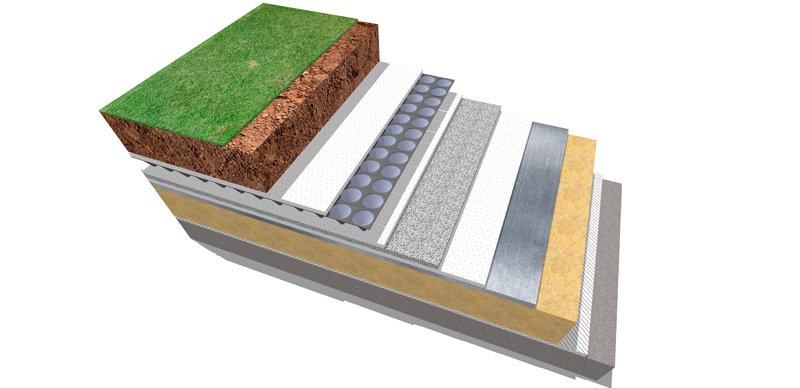Storm-water management
SINTEC green roofs make use of existing roof space and prevent runoff before it leaves the lot, storing water during rainfall events, delaying runoff until after peak rainfall and returning precipitation to the atmosphere through evapotranspiration. The depth of substrate, the slope of the roof, the type of plant community, and rainfall patterns affect the rate of runoff. SINTEC green roofs can reduce annual total building runoff by as much as 60% to 79%.
Extended roof life
By physically protecting against UV light and reducing temperature fluctuations, SINTEC green roofs extend the life span of the roof’s waterproofing membrane and improve building energy conservation. Although nowadays the membranes have an expected life of more than 25 years, the fact that they are protected from weather conditions means this is possibly much higher (over 50 years). Temperature stabilization of waterproofing membranes by green-roof coverage may also extend their useful life. An unvegetated reference roof could reach temperatures higher than 70 ºC in summer, while the surface temperature of the SINTEC green roof only reaches 30°C.
Energy management
During warm weather, SINTEC green roofs reduce the amount of heat transferred through the roof, thereby lowering the energy demands of the building’s cooling system.
In summer, SINTEC green roofs reduce heat flux through the roof by promoting evapotranspiration, physically shading the roof, and increasing the insulation and thermal mass.
Urban heat island
In urban environments, vegetation has largely been replaced by dark and impervious surfaces (e.g., asphalt roads and roofs). These conditions contribute to an urban heat island whereby urban regions are significantly warmer than surrounding suburban and rural areas, especially at night. This effect can be reduced by increasing albedo (the reflection of incoming radiation away from a surface) or by increasing vegetation cover with sufficient soil moisture for evapotranspiration.
Urban ecology
Green-roof habitats show promise for contributing to local habitat conservation. Living roofs also provide aesthetic and psychological benefits for people in urban areas. Even when SINTEC green roofs are only accessible for visual relief, the benefits may include relaxation and restoration, which can improve human health. Other uses for SINTEC green roofs include urban agriculture: food production can provide economic and educational benefits for urban dwellers. Living roofs also reduce sound pollution by absorbing sound waves outside buildings and preventing inward transmission.
Water quality
The role of SINTEC green roofs in storm-water retention is well understood, but some research demonstrates that green-roof runoff includes increased levels of nitrogen and phosphorus due to leaching from the substrate. Organic matter, nutrients, and contaminants in the growing medium or roof membranes can cause discharged water to be a new source of surface-water pollution. Research on more inert substrates, and on integrated grey-water reuse systems, may lead to mitigation of these effects.
Air quality
Although extensive SINTEC green roofs, as they are low in biomass, have little potential to offset carbon emissions from cities, intensive roof gardens that support woody vegetation could make significant contributions as an urban carbon sink. Urban vegetation is known to trap airborne particulates and to take up other contaminants such as nitrogen oxides.
Noise and sound reduction
The SINTEC green roof system can reduce external sound by 8-10db compared with a conventional roof system. The vegetation barrier and entrapped air within the vegetation acts as a sound insulation barrier and sound waves are absorbed, reflected or deflected.
Recyclable materials
Many of the products used within the SINTEC green roof system are recyclable or made from recyclable building materials, rubber or plastic. Where possible, depending on project location, the SINTEC green roof system can re-use secondary aggregates.



